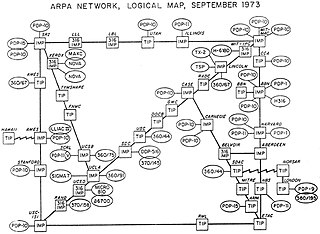
The history of the Internet has its origin in the efforts of scientists and engineers to build and interconnect computer networks. The Internet Protocol Suite, the set of rules used to communicate between networks and devices on the Internet, arose from research and development in the United States and involved international collaboration, particularly with researchers in the United Kingdom and France.
Internetworking is the practice of interconnecting multiple computer networks, such that any pair of hosts in the connected networks can exchange messages irrespective of their hardware-level networking technology. The resulting system of interconnected networks is called an internetwork, or simply an internet.
The Internet Protocol (IP) is the network layer communications protocol in the Internet protocol suite for relaying datagrams across network boundaries. Its routing function enables internetworking, and essentially establishes the Internet.
The Internet protocol suite, commonly known as TCP/IP, is a framework for organizing the set of communication protocols used in the Internet and similar computer networks according to functional criteria. The foundational protocols in the suite are the Transmission Control Protocol (TCP), the User Datagram Protocol (UDP), and the Internet Protocol (IP). Early versions of this networking model were known as the Department of Defense (DoD) model because the research and development were funded by the United States Department of Defense through DARPA.

In digital radio, packet radio is the application of packet switching techniques to digital radio communications. Packet radio uses a packet switching protocol as opposed to circuit switching or message switching protocols to transmit digital data via a radio communication link.

A router is a computer and networking device that forwards data packets between computer networks, including internetworks such as the global Internet.

In telecommunications, packet switching is a method of grouping data into short messages in fixed format, i.e. packets, that are transmitted over a digital network. Packets are made of a header and a payload. Data in the header is used by networking hardware to direct the packet to its destination, where the payload is extracted and used by an operating system, application software, or higher layer protocols. Packet switching is the primary basis for data communications in computer networks worldwide.

Raytheon BBN is an American research and development company based in Cambridge, Massachusetts, United States.

The Advanced Research Projects Agency Network (ARPANET) was the first wide-area packet-switched network with distributed control and one of the first computer networks to implement the TCP/IP protocol suite. Both technologies became the technical foundation of the Internet. The ARPANET was established by the Advanced Research Projects Agency of the United States Department of Defense.

Robert Elliot Kahn is an American electrical engineer who, along with Vint Cerf, first proposed the Transmission Control Protocol (TCP) and the Internet Protocol (IP), the fundamental communication protocols at the heart of the Internet.

SRI International (SRI) is a nonprofit scientific research institute and organization headquartered in Menlo Park, California, United States. It was established in 1946 by trustees of Stanford University to serve as a center of innovation to support economic development in the region.
Peter Thomas Kirstein was a British computer scientist who played a role in the creation of the Internet. He made the first internetworking connection on the ARPANET in 1973, by providing a link to British academic networks, and was instrumental in defining and implementing TCP/IP alongside Vint Cerf and Bob Kahn.

A computer network is a set of computers sharing resources located on or provided by network nodes. Computers use common communication protocols over digital interconnections to communicate with each other. These interconnections are made up of telecommunication network technologies based on physically wired, optical, and wireless radio-frequency methods that may be arranged in a variety of network topologies.
Virgil Donald Cone was a technician and later researcher at SRI International who developed and ran the Packet Radio Van that was used in the first ARPANET internetworked transmission.

The NPL network, or NPL Data Communications Network, was a local area computer network operated by a team from the National Physical Laboratory (NPL) in London that pioneered the concept of packet switching.

SATNET, also known as the Atlantic Packet Satellite Network, was an early satellite network that formed an initial segment of the Internet. It was implemented by BBN Technologies under the direction of ARPA.

The Packet Radio Network (PRNET) was a set of early, experimental mobile ad hoc networks whose technologies evolved over time. It was funded by the Advanced Research Projects Agency (ARPA). Major participants in the project included BBN Technologies, Hazeltine Corporation, Rockwell International's Collins division, and SRI International.
The International Network Working Group (INWG) was a group of prominent computer science researchers in the 1970s who studied and developed standards and protocols for interconnection of computer networks. Set up in 1972 as an informal group to consider the technical issues involved in connecting different networks, its goal was to develop an international standard protocol for internetworking. INWG became a subcommittee of the International Federation for Information Processing (IFIP) the following year. Concepts developed by members of the group contributed to the Protocol for Packet Network Intercommunication proposed by Vint Cerf and Bob Kahn in 1974 and the Transmission Control Protocol and Internet Protocol (TCP/IP) that emerged later.
The Protocol Wars were a long-running debate in computer science that occurred from the 1970s to the 1990s, when engineers, organizations and nations became polarized over the issue of which communication protocol would result in the best and most robust networks. This culminated in the Internet–OSI Standards War in the 1980s and early 1990s, which was ultimately "won" by the Internet protocol suite (TCP/IP) by the mid-1990s when it became the dominant protocol suite through rapid adoption of the Internet.












